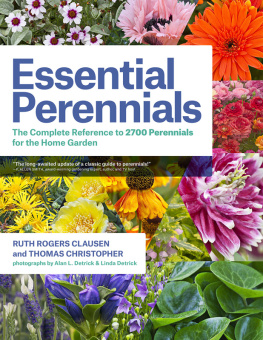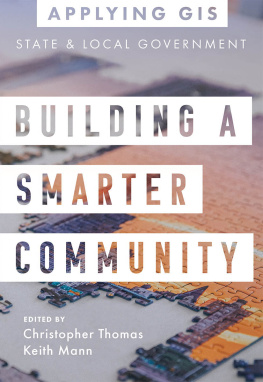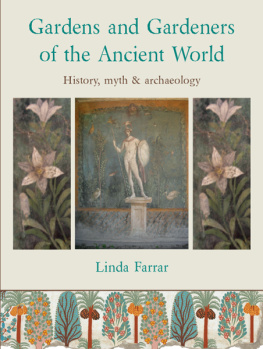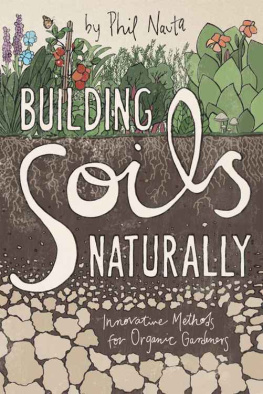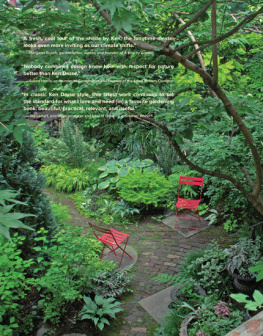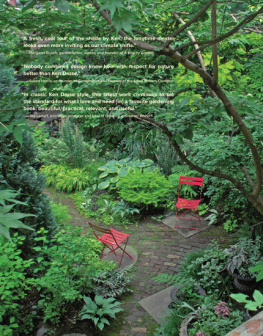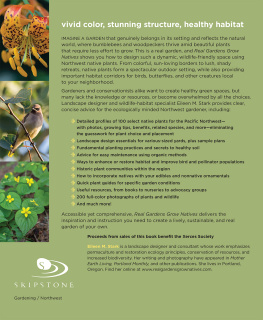
This pond and waterfall were designed to appear as though they were naturally occurring.
GARDEN REVOLUTION
How our landscapes can be a source of environmental change
LARRY WEANER
THOMAS CHRISTOPHER

This book is dedicated to my parents, Herb and Elaine Weaner, who each in their own way taught me to think for myself. Outside of their love and support, I have never received a more valuable gift. And of course to Team Weaner: Linda, Jan, Sara, and brother Mark. I love you all very much.
LARRY WEANER
To Suzanne, as always.
THOMAS CHRISTOPHER

A wasp visits Indian plantain.
CONTENTS
PREFACE
Every book is born of collaborations between writers, editors, designers, and publishers. This book is even more of a collaboration than most.
When I met Larry Weaner, I was looking for something more, something new. As a horticulturist, I had become keenly aware that the traditional way of doing things in my field was unsustainable, that much of what I was taught to do during my schooldays was actively harmful to the environment. I wanted my garden to be more than just attractive and fruitful. I wanted it to make a positive contribution to the natural scene around it, to design it so that, in its own modest way, my garden would provide what ecologists call ecosystem services.
When I heard Larry Weaner speak at one of his annual ecological landscaping conferences, I knew I had found my answer. The strategies he laid out promised to make each garden a source of ecological renewal. Whats more, he had the experience to prove his strategies could work. By the time I heard him talk, he had been designing gardens for more than three decades and had hundreds of satisfied clients to attest to the effectiveness of his concepts.
Not long afterward, Larry contacted me and suggested that I help him write a book. And so a partnership was born. Relying on my own decades of horticultural experience, I began to pose questions. From the answers, Larry and I began to assemble a text. I contributed my own experiences gained from my work with sustainable lawns. In addition, although Larry is an experienced and expert teacher, my own status as a newcomer to Larrys system of horticulture helped us to identify how to structure the book in a way that was accessible to the average reader.
We chose to tell this story in Larrys voice because it is his story. As I became more involved, however, and began to apply Larrys insights to my own garden, it became my story as well. Our hope is that readers will follow the same path and that this story will become your story, too. As it does, I foresee a time when the collaboration intrinsic to this book will take on a new dimension, and many more gardens and back yards all across North America will make their own contributions to the health and beauty of their local ecosystems. That surely is a collaboration, a new partnership, well worth pursuing.
Thomas Christopher

Neither the hairy alumroot on the right nor the cardinalflower on the left was planted here. Their presence is a result of self-proliferation and human landscape manipulations.


I dont recall whether this color combination was intentionalbut Ill take it.
ECOLOGICAL GARDENING
AN INTRODUCTION
I have been profoundly influenced by the activists who, since the publication of Rachel Carsons Silent Spring (and in some cases even before that), have been working to reverse the harmful habits into which much of gardening had fallen. There are powerful environmental reasons for bringing our gardens into a sounder relationship with nature. However, I am not hoping to convert readers by teaching them that this kind of gardening is morally or environmentally the right thing to do. Instead, I honestly believe that having once sampled an ecologically driven approach, gardeners wont want to do anything else. For me, the most persuasive reasons are that its easier and far more rewarding to transform the human landscape in this fashion.
Through my many years of experience, I have learned to treasure the subtle and unpredictable beauties of a garden that collaborates with the local ecology. I prefer to work with a landscape that, at least in part, evolves over time according to natural processes of change and plants itself. I find the diversity of an evolving gardens plant and animal residents fascinating, and the way in which the landscape or garden recruits new inhabitants as it evolves is one of its most satisfying and richest aspects.
A large part of what I advocate is the shedding of conventional gardenings counter-productive practices. The ways in which gardeners till and weed, irrigate, and fertilize their plots, for example, cause perpetual disturbance to the ecologies of those areas and create an irresistible invitation to invasive species. And the ways we were taught to combat those invaders ensure that the struggle will never end. Unfortunately, though perhaps not surprisingly, many of these counter-productive practices have been perpetuated by the more recent schools of natural gardening that, though they have an admirable emphasis on the use of native species, still commonly arrange and maintain plantings in a conventional way.
These impediments can best be corrected by a return to first principles, by studying how plants and wildlife associate in a natural state and basing our gardening on that. My experiences have taught me that this change of behavior brings not only better resultsa healthier, more dynamic landscapebut also one that demands far fewer inputs. I am selfish enough to have found the latter a powerful motivation to change, and I suspect readers will react similarly.
In this alternative approach, less is truly more. Minimizing intervention and letting the indigenous vegetation dictate plant selection and, as much as possible, do the planting, produces a garden landscape that flourishes without the traditional injections of irrigation and fertilizers and is better able to cope on its own with weeds and pests. The gardeners input becomes a matter of directing the garden ecosystems evolution into desirable paths and capitalizing on positive developments as they occur. This more fluid style of gardening frees the owner from the drudgery inherent in the traditional attempt to keep the landscape fixed according to some artificial blueprint.
At the same time, this kind of gardening fulfills many of the goals promoted by the environmental activists. It turns the landscape from a consumer of resources and a polluter into a source of environmental renewal: a nexus of stormwater absorption and purification, a sanctuary for indigenous wildlife, and a protector of biodiversity. These are all important, even essential. What I relish most, though, and what I believe will speak most powerfully to readers is the unique beauty and rich experience that this ecologically based style of gardening produces.
Next page

